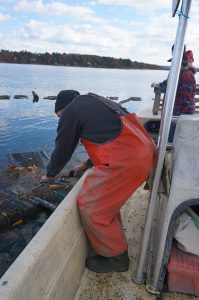Ergonomics and Fishing: Part 1
As published on Page 28 in the SEPTEMBER 2023 issue of Commercial Fisheries News

Few jobs are as physically punishing as commercial fishing. The average day’s work would challenge any CrossFit program, with the added strain of being done in positions and conditions markedly less ideal than in the gym. The risk for musculoskeletal injuries, both short term and chronic, is high.
Ergonomic practices and products can help to greatly reduce these risks. Ergonomics went home with workers during COVID. As offices went remote, people moved from the office building desk to kitchen table, couch, and even recliner. Doubtlessly, many initially thought this the silver lining of a bleak time, but soon droves of workers were complaining of back, neck, and shoulder pains, and hand and wrist issues. In an effort to address this, employers began offering sit-to-stand style desks, ergonomic chairs, and keyboards for home use. Musculoskeletal complaints dropped.
Commercial fishing environments are much more dynamic than a desk job, and ergonomics has as much or more to offer commercial fishermen. Ergonomics is a science, and people spend their lives in the field, but you do not need a license or certificate to adapt or improve your own equipment yourself.

Industries are often sluggish when it comes to identifying needs. For example, autos and cigarettes both became popular in the 1920s and exploded in growth together for half a century, but it wasn’t until the 1950s that most cars came with the simple ashtray!
With the exception of the addition of davit and crane, the ergonomics of lobster boats essentially haven’t changed much over generations. The aquaculture farmers I’ve met don’t yet have boats designed for their work. I’ve seen them make due with lobster boats, Carolina skiffs, and simple motor boats. These boats are ill-suited to the repetitive bending the farmers do as they strain to flip 50-100# oyster bags. Cranes designed for lobstering are helpful but inefficient, and the few bag flipping systems currently available aren’t affordable for most small operations. Farmers tending kelp lines fare no better.
Perhaps an increased interest in aquaculture, ever-rising health costs, and an aging workforce may conspire to spur ergonomic improvements in gear and practices, but we shouldn’t wait for someone else to meet our workplace challenges. One of the things I’ve noticed about the work culture of the aquaculture industry is a spirit of cooperation between farms. Sharing innovations that work can lead to both physical well being and better productivity for everyone.
A few key things when making/modifying the environment or tools:
- Develop systems promoting good posture.
- Keep wrists in neutral alignment whenever possible.
- Avoid awkward twisting motions and off-balance positioning.
- Design for task duration. There are 99 reasons why doing something once is different than doing it 100 times.
- Your clothes fit your size–make sure your work stations and tools do, too.
- Safety promotes productivity–a worker off with an injury has zero productivity.
If you are experiencing pain or injuries as a result of the rigors of fishing, or have a condition that presents challenges at work, Fishability offers free consultations on your boat or other worksite. Our staff will discuss techniques and equipment best suited to your needs to keep you working safer, more efficiently, and more comfortably. Fishability is dedicated to helping fishermen keep fishing.
